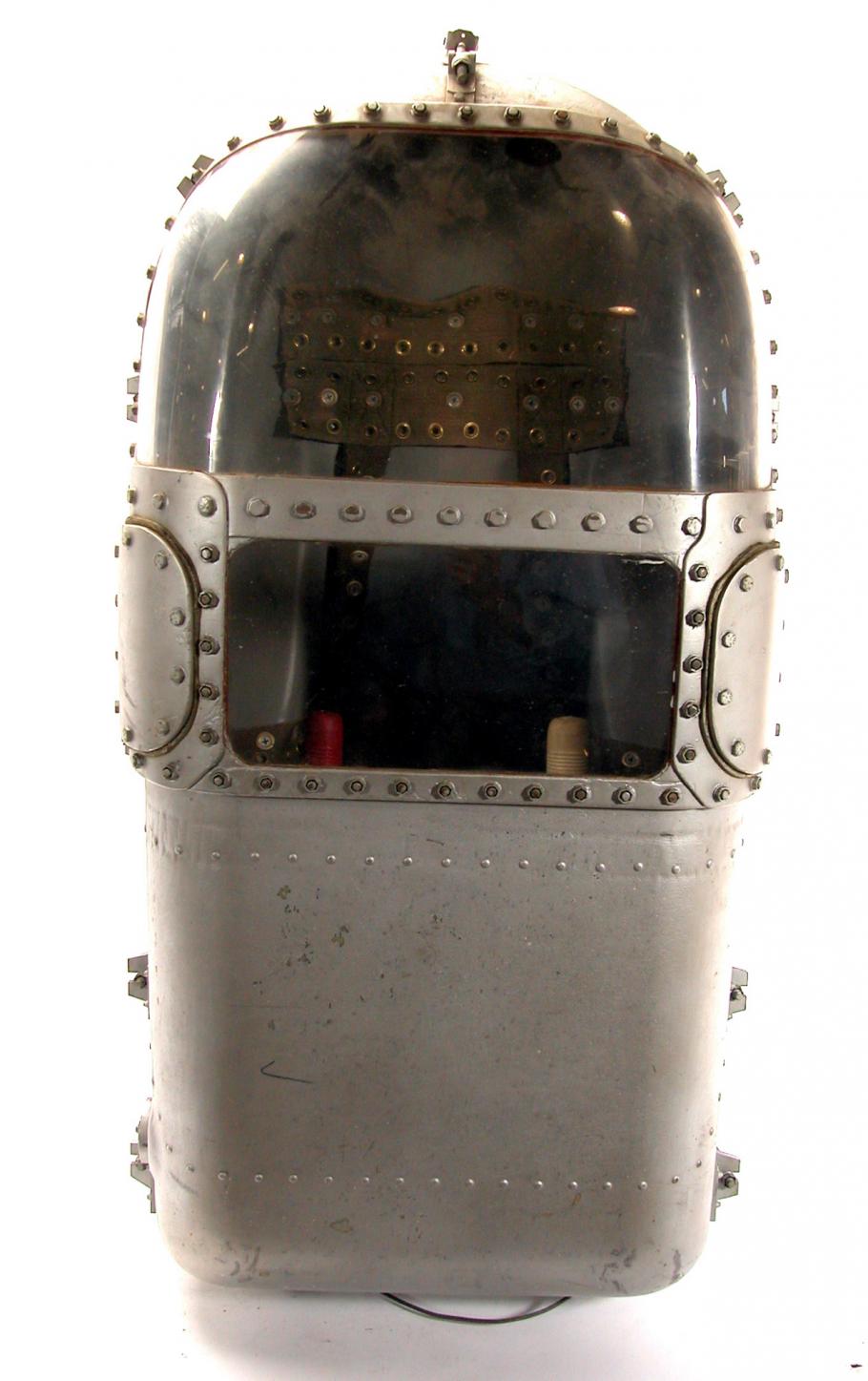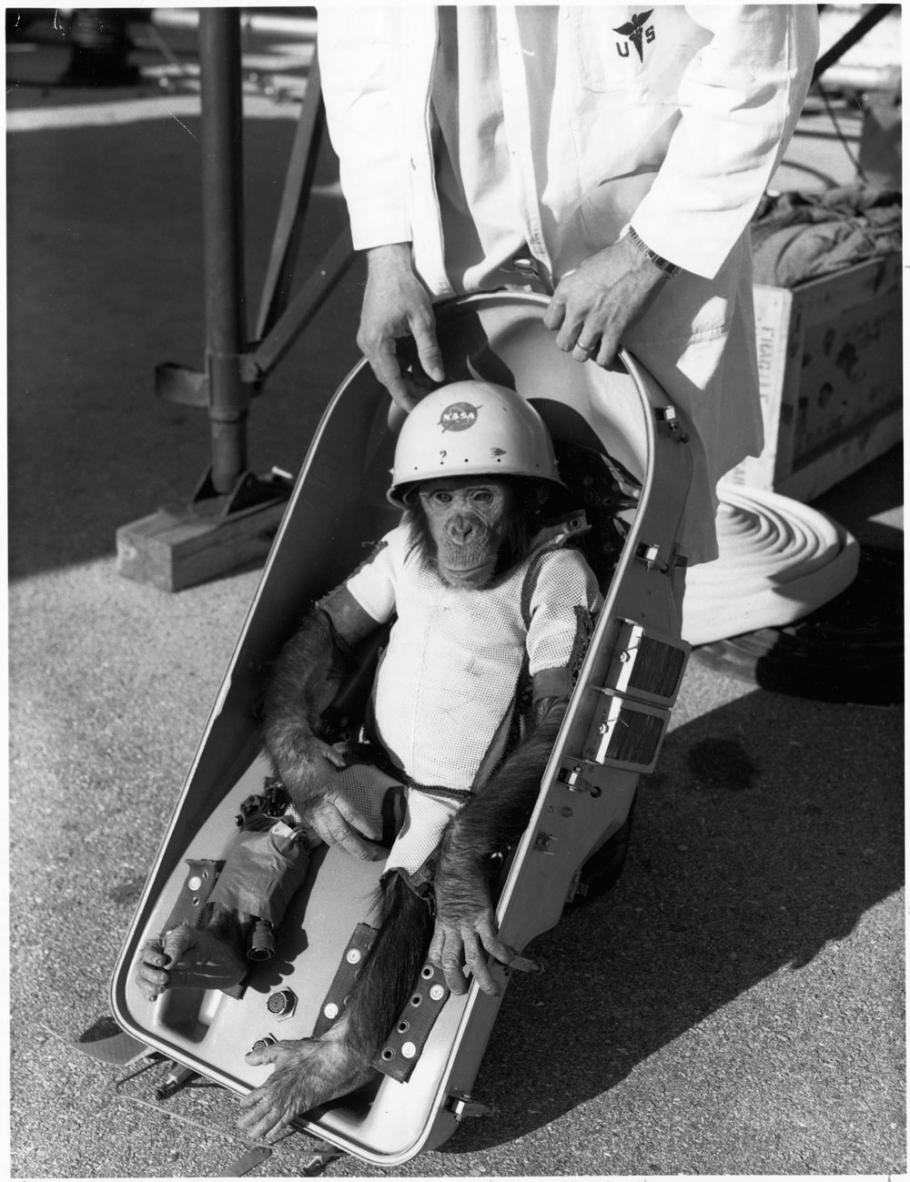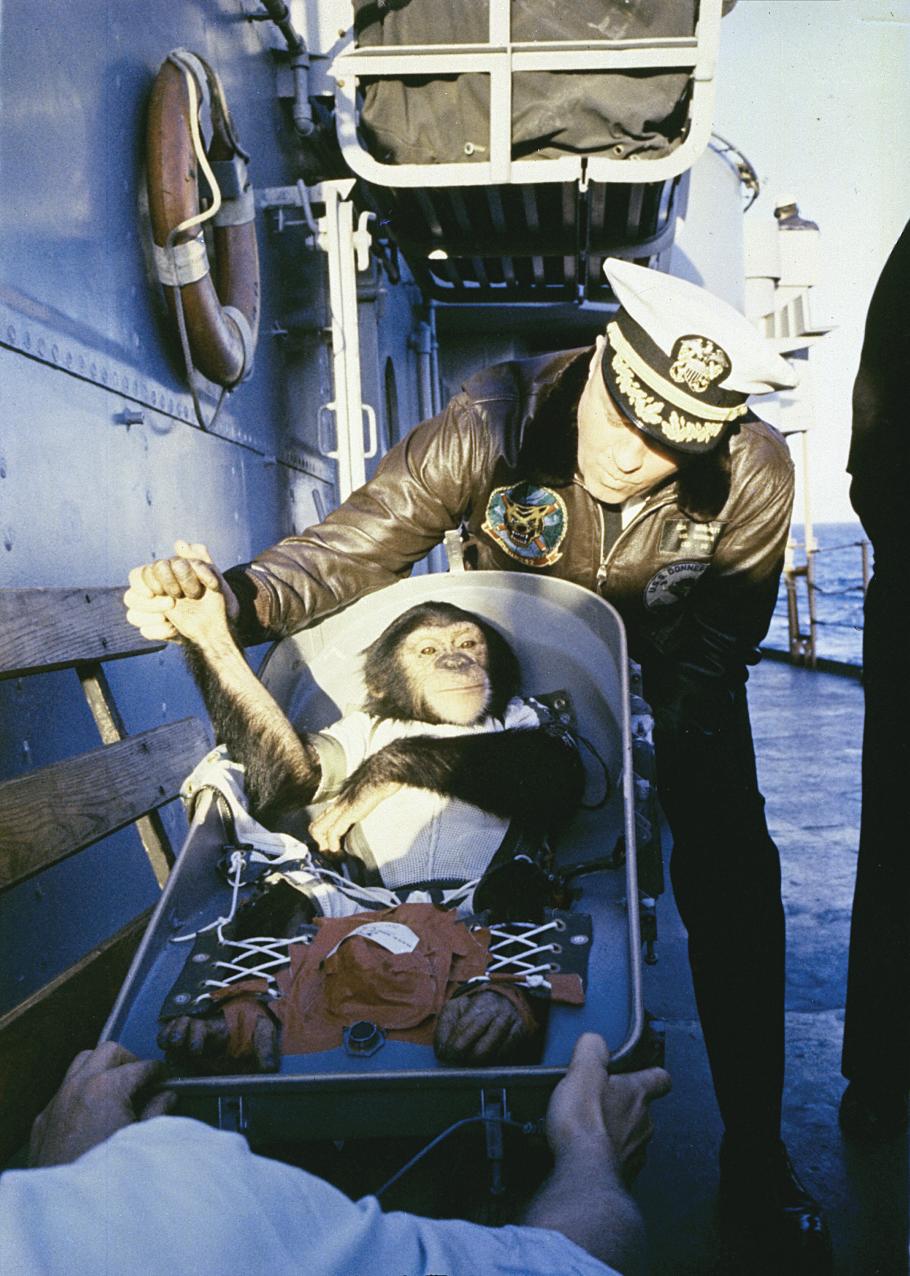On May 5, 1961, Alan Shepard became the first American in space. However, three months earlier NASA had launched “Number 65” on a mission that helped pave the way for Shephard’s momentous flight. Number 65 was a male chimpanzee born in 1957 in the French Cameroons in West Africa. After being captured by trappers, he was sent to a rare bird farm in Florida. In 1959, he was sold to the U.S. Air Force, who sent him to Holloman Air Force Base in New Mexico. There he would take part in training to become an astrochimp. Nicknamed “Ham” by his handlers (after Holoman Aerospace Medical Center), Number 65 was one of 40 chimps chosen for the space program. While numerous animals had been launched into space by both the Americans and Soviets as early as 1948 (dogs, monkeys, mice, a rabbit, and even fruit flies), the test subjects had thus far been mere passengers. By the 1950s, before sending a human into the unknown, NASA wanted to conduct tests to find out if an astronaut would be able to perform motor tasks in space. Why were chimpanzees chosen, and what would they do that the other animals did not? According to NASA’s publication, This New Ocean: A History of Project Mercury, (“Ham Paves the Way” chapter):
Intelligent and normally docile, the chimpanzee is a primate of sufficient size and sapience to provide a reasonable facsimile of human behavior. Its average response time to a given physical stimulus is .7 of a second, compared with man's average .5 second. Having the same organ placement and internal suspension as man, plus a long medical research background, the chimpanzee chosen to ride the Redstone and perform a lever-pulling chore throughout the mission should not only test out the life-support systems but prove that levers could be pulled during launch, weightlessness, and reentry.
The chimps were taught to pull levers in response to sound and light. If they reacted correctly within five seconds, they were rewarded with banana pellets; if not, they got a mild shock on the soles of their feet. The animals were also exposed to simulated g-forces and microgravity to prepare them for spaceflight, just like their human counterparts, the “Mercury Seven,” who had been training for nearly two years.
As tests proceeded, the group of would-be space travelers was whittled down to 18, and then six (four females and two males). Ham was chosen as one of the finalists. On January 2, 1961, the six animals were moved from Holloman to Cape Canaveral, Florida, and separated into two groups. This was to avoid the spread of germs to all the chimps should one become ill. Mercury capsule mock-ups were built for both groups, and the chimps spent their days performing motor tasks during 29 training sessions lasting until the third week in January. Until the day before the scheduled launch date of January 31, all six finalists were still in the running for the title of first chimp in space. Then, the decision had to be made about which of them would go on the flight. James P. Henry of NASA’s Space Task Group (STG) and John D. Mosely, the veterinarian from Holloman, would make the selection after the animals were given physical examinations and other tests. Ham, who was acting particularly feisty and in good humor, got the nod, and a female chimp was selected as alternate. A History of Project Mercury details what happened next:
At nineteen hours before launch these two animals were put on low-residue diets, fitted with biosensors, and checked out in their pressurized couch-cabins. Seven and one-half hours before the flight a second physical examination was given, followed by more sensor and psychomotor tests. About four hours before launch, the two chimps were suited up, placed in their couches, and brought aboard the transfer van, where their environmental control equipment was attached. The trailer truck arrived at the gantry alongside MR-2, and there, an hour and a half before the scheduled launch time, the chimpanzee named "Ham," … still active and spirited although encased in his biopack, boarded the elevator to meet his destiny.
Ham rode into space in Mercury spacecraft #5, boosted by a Mercury-Redstone 2 rocket. He was strapped into a harness inside a pressurized capsule like the one below. This is the “couch-cabin” referred to above. The capsule would allow him to breathe if the cabin pressure in the spacecraft failed. The Museum has seven primate capsules, but none is currently on public display. The capsules are made of aluminum and fiberglass, with two Plexiglas windows. They measure 101.6 x 50.8 x 40.64 centimeters (40 x 20 x 16 inches), and were manufactured by McDonnell Aircraft Corp.
During the flight, Ham’s reaction to weightlessness and acceleration was tested by his performing the lever-pulling tasks he had trained for. According to A Brief History of Animals in Space published by the NASA History Office, the flight did not go completely as planned:
The original flight plan called for an altitude of 115 miles and speeds ranging up to 4,400 mph. However, due to technical problems, the spacecraft carrying Ham reached an altitude of 157 miles and a speed of 5,857 mph and landed 422 miles downrange rather than the anticipated 290 miles… He experienced a total of 6.6 minutes of weightlessness during a 16.5-minute flight.
In addition, there was a partial loss of air pressure while in space, but disaster was averted because of the pressurized capsule encasing Ham. After splashdown, water flooded the capsule and if the rescue helicopter had not arrived when it did, Ham might have drowned.
Despite these difficulties, Ham seemed calm and in good spirits upon his return. He shook hands with the commander of the recovery ship and others, and readily accepted an apple. He did become agitated later when faced with the paparazzi, however, according to the post-flight report:
Robert F. Wallace, an STG information officer on the scene, reported that Ham was excited when returned to Hangar S after his flight. Being unable to debrief his handlers, Ham alone knew at this time how grueling his flight had been. Flashbulbs and crowding newsmen made him highly agitated, and he snapped at several people... Later, when his handler led him back toward a capsule for pictures requested by the TV crews, Ham again became highly perturbed. It took three men to calm the ‘astrochimp’ for the next round of pictures.
A medical examination revealed Ham was slightly fatigued and dehydrated, but otherwise fine. Results of the tasks he performed showed his reaction times were only slightly slower than on Earth, proving that astronauts could perform activities effectively in space. But Ham’s contribution to the future of human spaceflight was much more than that. To quote A History of Project Mercury:
Ham's flight on MR-2 was a significant accomplishment on the American route toward manned space flight. Now the Space Task Group knew that even with some hazardous malfunction it might reasonably hope to complete a manned ballistic mission successfully. Ham's survival, despite a host of harrowing mischances over which he had no control, raised the confidence of the astronauts and the capsule engineers alike.
Ham gained instant fame, and was featured in numerous articles, on magazine covers, and on television many times. Documentaries were made about him. He lived at the Smithsonian’s National Zoo in Washington, DC until 1980, when he was transferred to the North Carolina Zoological Park in Asheboro. When he died in 1983, Ham's skeleton went to the Armed Forces Institute of Pathology for further investigation. His other remains were buried at the International Space Hall of Fame in Alamogordo, New Mexico. A second astrochimp, Enos, was launched into space in November 1961, this time entering Earth orbit. It was the precursor to John Glenn’s orbital flight in 1962. Watch a nine-minute video about Ham’s training and spaceflight.



